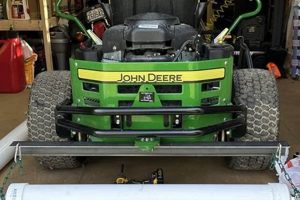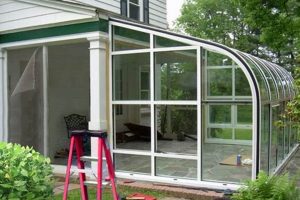This product provides all the necessary components for individuals to create customized garden features. Typically, it contains a mold, concrete mix, and decorative elements such as stones, glass, or tiles. The user combines these elements to form a personalized garden pathway accent.
Its appeal lies in the combination of creative expression and cost-effectiveness. Rather than purchasing pre-made versions, individuals can design and construct unique landscape elements that reflect personal style and preferences. The historical context reveals a long-standing tradition of homeowners personalizing their outdoor spaces, now facilitated by readily available materials.
The subsequent discussion will delve into the specific components often included, the range of design possibilities, and the step-by-step process for successful implementation, followed by insights on where to source these products, and safety considerations for creating durable, long-lasting outdoor decorations.
Tips for Optimal Results
Achieving satisfactory results with these sets requires careful attention to detail and adherence to best practices. The following tips will enhance the likelihood of creating durable and aesthetically pleasing landscape features.
Tip 1: Concrete Consistency. Proper water-to-mix ratio is paramount. Too much water weakens the concrete, leading to cracking. Too little water results in a crumbly mixture that will not properly bind. Follow the manufacturer’s instructions meticulously.
Tip 2: Mold Preparation. Before pouring the concrete mixture, lightly coat the mold with a release agent, such as cooking spray or petroleum jelly. This facilitates easy removal of the hardened product and prevents damage during demolding.
Tip 3: Decorative Element Placement. Even distribution of decorative elements is crucial for visual appeal and structural integrity. Ensure that stones, glass, or tiles are firmly embedded in the concrete mixture before it sets.
Tip 4: Curing Process. The curing process is essential for concrete strength. Keep the freshly poured stepping stone moist by covering it with plastic sheeting or damp burlap for several days. This prevents rapid evaporation and promotes proper hydration of the cement.
Tip 5: Reinforcement Considerations. For larger or more intricate designs, consider adding reinforcement, such as wire mesh or fiberglass fibers, to the concrete mixture. This will increase the structural integrity and resistance to cracking.
Tip 6: Environmental Conditions. Avoid working in extreme temperatures. High heat accelerates the drying process, potentially leading to cracks. Cold temperatures can impede the setting process and weaken the concrete.
Tip 7: Mold Stability. Ensure the mold is placed on a level surface before pouring the concrete. Uneven surfaces can result in uneven thickness and structural weaknesses in the finished product.
By adhering to these guidelines, individuals can maximize the potential of these sets, producing visually appealing and structurally sound landscape elements. Careful preparation, execution, and curing are the keys to success.
The subsequent sections will address product sourcing, safety precautions, and long-term maintenance strategies to ensure the longevity and aesthetic appeal of these handcrafted features.
1. Component Selection
Component selection directly dictates the aesthetic and structural qualities of the finished product. The selection of materials profoundly impacts the final outcome. For example, opting for high-quality concrete mix versus a generic brand influences resistance to cracking and weathering. Similarly, the choice of decorative elements, such as river stones versus glass fragments, affects the visual style and suitability for specific garden environments. Inferior components lead to a structurally weak and aesthetically unappealing stepping stone, negating the benefits of the activity.
Consider a hypothetical scenario: two individuals undertake the same project, but one chooses UV-resistant glass and frost-proof tiles, while the other selects standard craft-store glass and porous ceramic. Over time, the first individual’s creation will retain its vibrancy and structural integrity, while the second’s will likely exhibit fading, cracking, and potential disintegration. Another aspect to consider is the source of raw materials for these kits. If an individual uses recycled materials, like repurposed glass or broken ceramics, they can improve the environmental impact and promote sustainable living.
Therefore, understanding the causal relationship between materials and product durability is crucial. In this context, selection becomes a foundational skill for achieving a desired outcome. Failure to prioritize component quality undermines the cost-effectiveness and personalized expression. Prioritizing durable, high-quality components ensures long-lasting landscape features, while inferior materials negate the economic and artistic advantages.
2. Mixture Consistency
Mixture consistency is a critical determinant of structural integrity and longevity. Deviation from recommended ratios leads to predictable consequences. A mixture too wet results in excessive shrinkage during curing, increasing the risk of surface cracking and diminished compressive strength. Conversely, a dry mixture fails to hydrate the cement particles adequately, leading to a weak, crumbly stone susceptible to disintegration. A practical example is a garden pathway exposed to freeze-thaw cycles; a poorly mixed stone will crumble and deteriorate much faster than one with proper hydration.
Achieving the proper consistency requires careful measurement and thorough mixing. The ideal mixture should resemble a thick paste, holding its shape when molded but still pliable enough to allow the proper embedment of decorative elements. Small-scale examples of mixture consistency failure are readily observable. A cracked bird bath, a crumbling garden gnome, or a fractured paving stone are all likely casualties of flawed concrete mixtures. These everyday instances underscore the real-world impact of adhering to established guidelines.
The quality of the initial mixture is non-negotiable for these projects. While decorative aspects attract initial interest, it is the unseen concrete matrix that determines the product’s ultimate resilience. Consistent monitoring of water content, thorough blending of dry and wet ingredients, and adherence to manufacturer specifications constitute best practices. Addressing challenges in concrete mixing is crucial for the product. It assures durability, reduces waste, and ensures the aesthetic goals are met. A well-proportioned mixture, though perhaps less glamorous than the decorative elements, is the cornerstone of a successful project.
3. Decorative Integration
Decorative integration within do-it-yourself landscape elements represents the process of embedding aesthetic elements into the concrete matrix, thus imbuing functionality with personalized visual appeal. The effectiveness of this integration dictates the overall aesthetic success and the longevity of the resultant structure.
- Material Compatibility
Compatibility between decorative materials and concrete influences long-term bonding. Glass, for instance, expands and contracts at a different rate than concrete, potentially leading to separation and cracking over time. Stones, if porous, can absorb moisture, leading to freeze-thaw damage within the concrete. Selecting materials with similar expansion coefficients and low porosity is therefore essential.
- Embedment Depth and Distribution
The depth and distribution of decorative items impact both the visual appeal and structural integrity. Insufficient embedment leads to dislodgement from freeze-thaw cycles or physical contact. Uneven distribution compromises the load-bearing capacity and introduces stress points within the concrete structure. A uniform distribution, with adequate depth, provides both aesthetic balance and structural stability.
- Sealing and Protection
Sealing the surface after integration enhances weather resistance and prevents deterioration. Unsealed concrete is susceptible to staining, algae growth, and erosion from acidic rainwater. A high-quality concrete sealant provides a protective barrier, preserving the color and texture of both the concrete and the integrated decorative elements. Periodic reapplication of the sealant maintains long-term aesthetic appeal.
- Design Complexity and Structural Impact
Intricate designs involving a high density of decorative elements can weaken the concrete structure if not properly managed. Large voids created by decorative items can reduce the load-bearing capacity and increase the risk of cracking. Balancing aesthetic aspirations with structural realities is a crucial consideration. Simplifying the design or incorporating reinforcement measures mitigates these risks.
Effective decorative integration transforms a utilitarian landscape component into a personalized artistic expression. The meticulous selection of compatible materials, careful attention to embedment depth and distribution, surface sealing, and the mindful design complexity are the fundamental factors determining the aesthetic and functional success. These elements collectively elevate the finished product beyond mere functionality, infusing a personalized aesthetic dimension.
4. Curing Process
The curing process represents a fundamental and often overlooked stage in crafting durable stepping stones. The hydration of cement particles within the concrete mix, a chemical process crucial for strength development, occurs over an extended period. Premature drying interrupts this hydration, resulting in a weaker, more brittle final product prone to cracking and surface degradation. In the context of the kits, neglecting proper curing negates the benefits of careful material selection and precise mixing ratios.
The practical implication is evident in comparing two identical creations: one cured adequately by maintaining a moist environment for several days, and the other left to dry rapidly in direct sunlight. The properly cured stone exhibits superior resistance to impact, abrasion, and freeze-thaw cycles. Consider a stepping stone intended for a high-traffic garden path. A poorly cured unit will develop cracks and crumble under repeated use, while a diligently cured unit will maintain its structural integrity for years. Covering the stones to prevent too rapid evaporation after the molding process is a common practice to consider to improve the quality of it. It does not matter if the weather is warm, cool or cold, keeping it covered will help improve the overall strength and lifespan of the stepping stone. The curing process should be considered just as much as the materials for the kit.
The curing process is not merely an optional step, but an integral component determining the long-term performance and aesthetic appeal of the stepping stones produced. Proper curing demands a proactive approach to moisture management and a clear understanding of its effect on the concrete matrix. By acknowledging and actively managing the curing phase, individuals can ensure the longevity and durability, transforming a simple DIY project into a lasting addition to the landscape.
5. Structural Integrity
Structural integrity, in the context of the product, denotes the ability of the finished stone to withstand physical stresses without deformation or failure. This property is directly influenced by factors inherent in the product’s design and creation, impacting its longevity and suitability for its intended purpose. Deficiencies in structural integrity manifest as cracking, crumbling, or complete disintegration under load or exposure to environmental elements. A direct cause-and-effect relationship exists between adherence to recommended practices during construction and the structural integrity of the finished product. For example, insufficient concrete curing leads directly to reduced compressive strength and increased vulnerability to cracking.
The importance of structural integrity as a component stems from its direct correlation with both safety and cost-effectiveness. A structurally sound stepping stone provides a safe and stable walking surface, minimizing the risk of falls or injuries. Conversely, a structurally compromised stone presents a tripping hazard and necessitates premature replacement, thereby increasing long-term costs. Furthermore, the environmental impact of replacing disintegrating materials is greater than producing durable, long-lasting ones. A real-life example might include a garden path using stones that have deteriorated after a single winter, necessitating a complete reconstruction. This not only incurs additional expense but also represents a waste of resources and labor.
Understanding the connection between construction methods and structural integrity has significant practical implications. This understanding informs the choice of materials, the adherence to proper mixing and curing techniques, and the implementation of reinforcement measures where necessary. The correct application of these principles results in landscape features that are not only aesthetically pleasing but also safe, durable, and cost-effective. By prioritizing structural integrity, end-users can maximize the return on investment in their outdoor spaces and contribute to sustainable landscaping practices. Ignoring the importance of it would result in higher expense and the likelihood of personal injuries.
6. Weather Resistance
Weather resistance defines the ability of the completed pathway element to withstand environmental conditions such as precipitation, temperature fluctuations, and ultraviolet radi
ation without significant degradation. This property directly impacts the long-term performance and aesthetic appeal. Components within a kit vary in their inherent resistance. Concrete mix, decorative stones, and any sealants used contribute to or detract from overall weather resilience. Failure to consider this leads to cracking, fading, or disintegration, necessitating costly repairs or replacements. For instance, a kit utilizing non-frost-resistant tiles in a region with freezing winters will result in tile delamination and structural compromise.
The importance of weather resistance is underscored by its influence on lifespan and maintenance requirements. Kits designed for use in harsh climates require specific formulations of concrete and sealant that are resistant to freeze-thaw cycles and chemical degradation. Furthermore, the selection of decorative elements must account for their susceptibility to fading or discoloration from prolonged exposure to sunlight. As a practical example, consider two individuals using the same kit: one seals the finished stone with a UV-resistant coating, while the other does not. Over time, the unsealed stone will exhibit fading and surface deterioration, while the sealed one will retain its original appearance and structural integrity for a longer period.
Understanding the connection between weather resistance and kit selection has tangible benefits. Choosing a kit explicitly formulated for local climate conditions and employing appropriate sealing techniques ensures a durable and aesthetically pleasing outcome. This reduces the need for frequent repairs or replacements and minimizes the long-term cost of maintaining the product. Therefore, prioritizing weather resistance at the outset transforms a simple project into a lasting addition to the landscape, mitigating the risks associated with environmental exposure.
7. Placement Strategy
Placement strategy represents a critical, often overlooked aspect of utilizing a garden path creation set. Proper placement dictates not only the aesthetic appeal of the finished installation but also its functionality, safety, and long-term durability. Careful planning and execution of placement are essential for maximizing the benefits of the product.
- Path Layout and Flow
The path layout must consider the natural flow of traffic within the garden. A winding path encourages exploration and visual interest, while a straight path provides a direct and efficient route. Irregular spacing between pathway elements can disrupt the flow and create tripping hazards. Adapting the path to the contours of the land, avoiding overly steep inclines, and directing foot traffic away from vulnerable plants are all critical considerations.
- Substrate Preparation and Stability
The underlying soil or substrate must be properly prepared to ensure stability and prevent shifting. Removing vegetation, leveling the ground, and compacting the soil are essential steps. A layer of gravel or sand can improve drainage and prevent water accumulation beneath the stone, which can lead to cracking or displacement during freeze-thaw cycles. Neglecting substrate preparation results in an unstable path that requires frequent maintenance and poses a safety risk.
- Spacing and Alignment
Consistent spacing and alignment contribute to both visual appeal and ease of use. The stones should be spaced close enough to allow for comfortable strides but far enough apart to prevent tripping. Maintaining a consistent alignment creates a sense of order and guides the eye through the garden. Using a measuring tool and level ensures consistent spacing and prevents the path from appearing haphazard or uneven.
- Integration with Surrounding Landscape
The path should integrate seamlessly with the surrounding landscape. Consider the existing vegetation, hardscape features, and overall garden design. Using similar materials or colors can create a sense of harmony and cohesion. Avoid placing the stones in areas that are prone to flooding or erosion. Incorporating edging materials, such as rocks or mulch, can define the path and prevent soil from washing onto the surface.
Effective placement integrates aesthetic considerations with practical realities. By carefully planning the layout, preparing the substrate, maintaining consistent spacing and alignment, and integrating the path with the surrounding landscape, individuals can transform a simple project into a durable and visually appealing garden feature. Neglecting these principles undermines the potential, leading to an unstable, unsightly, and potentially unsafe installation.
Frequently Asked Questions
This section addresses common inquiries regarding the use of do-it-yourself garden feature sets. These answers provide clarity on key aspects of the process.
Question 1: What is the typical lifespan of pathway elements constructed using these sets?
Lifespan is highly dependent on material quality, construction technique, and environmental conditions. Properly constructed and maintained stones, utilizing quality concrete and sealant, can last for many years. Neglecting these factors will significantly reduce their longevity.
Question 2: Are specialized tools required for successful implementation?
While sophisticated equipment is not typically necessary, certain tools enhance the ease and quality of construction. A mixing trowel, measuring container, level, and rubber mallet are recommended for optimal results. Substitutions can be made, but precision and consistency are crucial.
Question 3: What measures can be taken to prevent cracking and crumbling?
Cracking and crumbling are primarily caused by improper mixing, inadequate curing, or exposure to freeze-thaw cycles. Adhering to recommended water-to-concrete ratios, ensuring proper hydration during curing, and applying a protective sealant are essential preventative measures.
Question 4: Can these pathway elements be painted or stained?
Painting or staining is possible, but the selection of appropriate products is critical. Use paints or stains specifically formulated for concrete, ensuring they are weather-resistant and compatible with the sealant (if applicable). Proper surface preparation, including cleaning and priming, is essential for adhesion.
Question 5: Is it possible to incorporate lighting elements into the product?
Incorporating lighting is feasible, but requires careful planning and execution. Consider the electrical requirements of the lighting elements, and ensure that all wiring is properly insulated and protected from moisture. Consult with a qualified electrician if unsure about safe installation practices.
Question 6: How should the product be stored during the winter months?
In regions with freezing temperatures, storing the finished pathway elements indoors is advisable to prevent damage from freeze-thaw cycles. If outdoor storage is unavoidable, cover them with a waterproof tarp to minimize moisture absorption.
The information provided offers practical guidance for addressing common challenges and ensuring the durability of do-it-yourself garden features.
The following section will explore sourcing options and safety considerations related to this project.
Conclusion
This exploration of “diy stepping stone kit” has emphasized the multifaceted nature of this product. From component selection to placement strategies, attention to detail and adhe
rence to best practices are paramount. Successful implementation requires not only creative expression but also a thorough understanding of material science, construction techniques, and environmental factors.
The potential for personalized, durable landscape features is undeniable, but realization hinges on informed decision-making and diligent execution. By prioritizing quality, precision, and safety, individuals can transform a simple project into a lasting testament to their craftsmanship and a valuable addition to their outdoor spaces. Continued research and careful planning are critical for those undertaking this endeavor.







